 Aquatic Insects of Michigan
Aquatic Insects of Michigan
by Ethan Bright, Museum of Zoology Insect Division and School of Natural Resources and Environment
University of Michigan
- Home
- Species Lists
- Coleoptera
- Diptera
- Ephemeroptera
- Acanthametropodidae
- Ameletidae
- Ametropodidae
- Arthropleidae
- Baetidae
- Baetiscidae
- Behningiidae
- Caenidae
- Ephemerellidae
- Ephemeridae
- Heptageniidae
- Isonychiidae
- Leptohyphidae
- Leptophlebiidae
- Metretopodidae
- Neoephemeridae
- Oligoneuriidae
- Palingeniidae
- Polymitarcyidae
- Potamanthidae
- Pseudironidae
- Siphlonuridae
- Heteroptera
- Hymenoptera
- Lepidoptera
- Megaloptera
- Neuroptera (Sisyridae)
- Odonata
- Orthoptera
- Plecoptera
- Trichoptera
- Other Orders
- Keys/Identification
- Aquatic Insects of Michigan
Baetiscidae (Baetisca) of Michigan - Identification
Introduction
under construction
Imagoes (adapted from Pescador and Berner 1981)
| 1a | Males (Fig. 1) | 2 |
| 1b | Females (end of abdomen not as in Fig. 1) | 4 |
| 2a | Penes lanceolate, apically blunt (Fig. 2) | Baetisca obesa (Say) |
| 2b | Penes deltoid, apically pointed (Fig. 3) | 3 |
Fig. 1 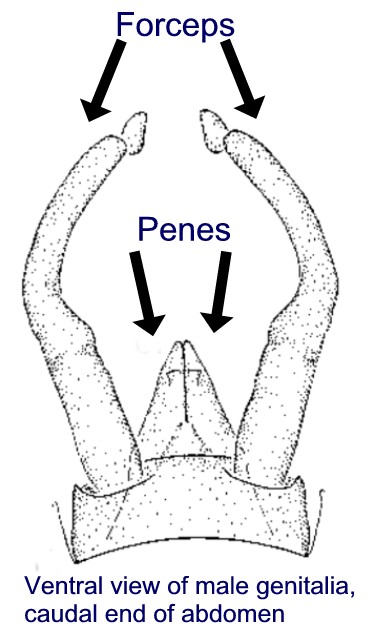 Fig. 2 Fig. 2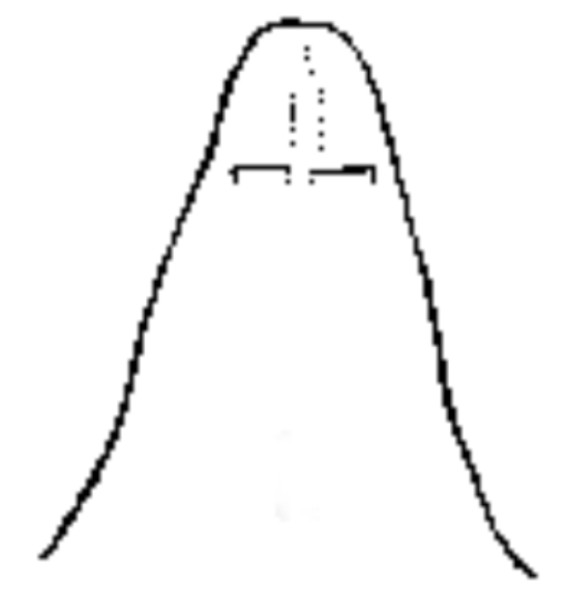 Fig. 3 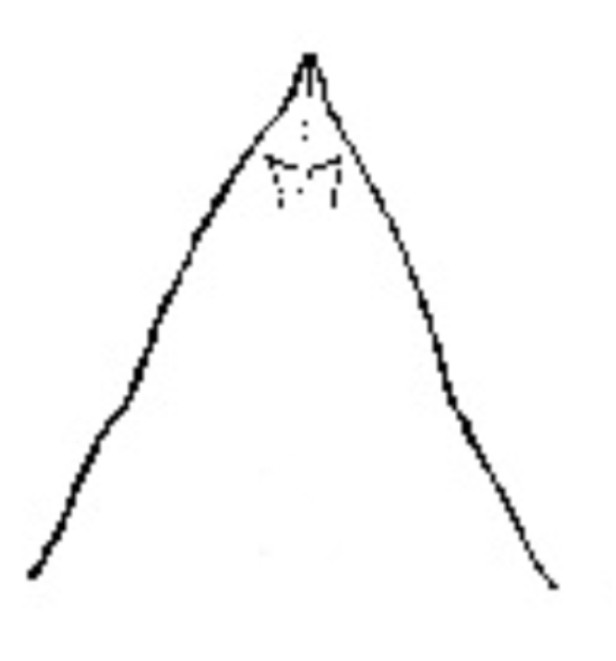 |
||
| 3a(2b) | Longitudinal veins of fore wing brown | Baetisca laurentina McDunnough |
| 3b | Longitudinal veins of fore wing pale, vein C, Sc, and R pale to light brown | Baetisca lacustris McDunnough |
| 4a(1b) | a. Body length approximately 6.5-8.5 mm | Baetisca lacustris McDunnough |
| b. Fore wing length 9.0-10.5 mm | ||
| c. Caudal filaments 5.0 mm, white to light brown | ||
| d. Abdominal terga white to grayish-brown, chalky-white on Ab7-10 terga | ||
| e. Legs light tan with few brown spots on the femora, tibiae with basal brown markings which almost completely encircle the metatarsus | ||
| 4b | a. Body length 8.3-12.3 mm | Baetisca laurentina McDunnough |
| b. Fore wing length 8.8-15.6 mm | ||
| c. Caudal filaments 5.0-8.3 mm, brown | ||
| d. Abdominal terga light brown | ||
| e. Legs brown, femora slightly darker than other leg segments | ||
| 4c | a. Body 7.0-9.0 mm | Baetisca obesa (Say) |
| b. Forewing 9.0-12.0 mm | ||
| c. Caudal filaments 5.5-7.0 mm, pale with brown annulations at articulations | ||
| d. Abdominal terga purplish-brown, darkest on Ab2-6, Ab7-10 tergites with submedial and posterolateral whites areas | ||
| e. Legs light brown washed with darker brown, most noticeable on femora | ||
Mature nymphs
| 1a | Dorsal projections on mesonotal shield weakly to moderately developed, their height less than, or subequal to, that of the medial hump | Baetisca lacustris McDunnough |
| also: Mesonotal shield distinctly longer than wide, and with a middorsal depression; lateral spines of the mesonotal shield > 1.5x as long as their basal width; thoracic and abdominal sterna freckled with brown spots; prominent brown spot on the thoracic sternum medial to each coxa (Fig. 4); posteromedian elevation on Ab7-9 tergites weakly developed | ||
| 1b | Dorsal projections on mesonotal shield well-developed, distinctly taller than medial hump | 2 |
Fig. 4 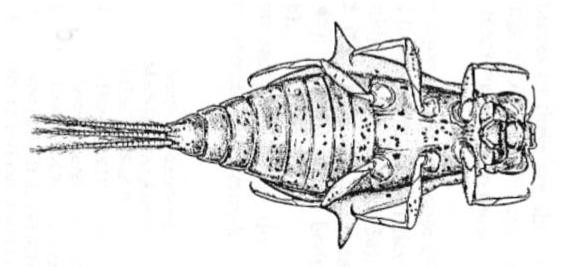 |
||
| 2a(1b) | a. Frontal projection well-developed, distinctly extended beyond the anterior margin of the head (Fig. 5) | Baetisca obesa (Say) |
| b. Ventral margins of the mesonotal shield lack a dark-brown outline | ||
| c. Ab2-6 sternites with prominent dark-brown spots near the lateral margin | ||
| 2b | a. Frontal projection developed, but not extended beyond the anterior margin of the head (Fig. 6) | Baetisca laurentina McDunnough |
| b. Ventral margins of the mesonotal shield prominently outlined with dark brown | ||
| c. Ab2-6 sternites lacking prominent dark-brown sublateral spots, but freckled with brown | ||
Fig. 5 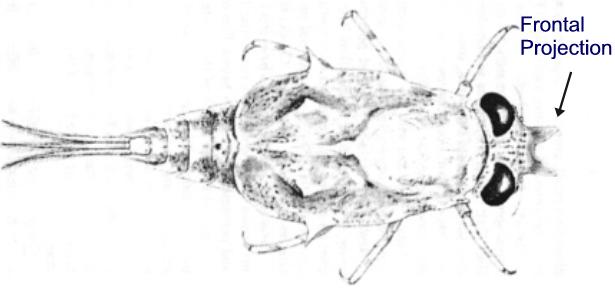 Fig. 6 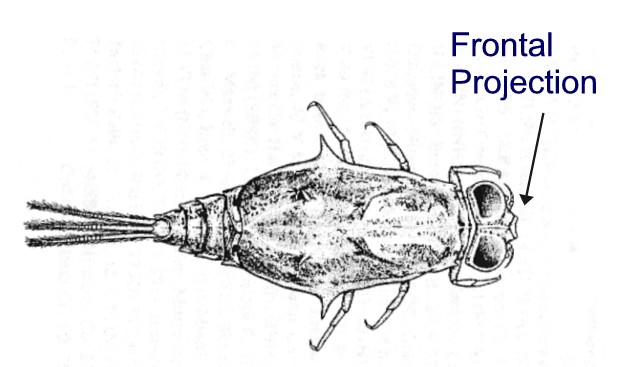 |
||
Species Descriptions
The following species descriptions are taken from Pescador and Berner (1981).
Baetisca lacustris McDunnough
Male imago (in alcohol). Body: Body length 6.9-9.0 mm; fore wing 9.0-10.5 mm; caudal filaments 5.0-8.0 mm. Head: Brown; antennae brown; eyes continguous dorsally. Thorax: Nota pale grayish to brown; scutellum brown with margins darker; sterna pale to light brown. Wings: Longitudinal veins of fore and hind wings usually colorless, sometimes with light brownish tint in C, Sc, and R1 of fore wing; membrane hyaline. Legs: Tan, washed with grayish-brown in some specimens; fore tarsi narrowly annulate with brown at each joint; meso- and metatarsi with a trace of a narrow, dark ring at each joint; claws pale to brownish. Abdomen: Terga white to grayish-brown, chalky-white laterally on tergites 7-10 in most individuals; sterna pale; genital forceps pale to brownish; penes deltoid, apically pointed, base gradually enlarged; caudal filaments white to light brown.
Female imago (in alcohol). Body: Body length 6.5-8.5 mm; fore wing 9.0-10.5; caudal filaments 5.0 mm. Other than sexually dimorphic traits, description of male same for female.
Mature nymph (in alcohol). Body: Body length 6.8-10.2 mm; caudal filaments 2.1-3.0 mm. Head: Tan with pronounced brown freckling [note: may be reduced]; small occipital tubercles; frontal projection small, anterior and posterior areas slightly depressed; genal shelf prominent and rounded at outer angle; antennae pale. Thorax: Mesonotal shield relatively broad, ratio of length-to-width 1.4:1.0; lateral spines of notal shield long, approximately 1.8x as long as basal width, sharply pointed [note: rarely may be rounded at tip, or long and pointed, or relatively short]; dorsal projections weakly developed, distinctly lower than medial hump; mesonotal shield tan, overlaid with extensive brown mottling; sterna tan with large brown spots; conspicuous brown spots between the pro- and mesocoxae and the meso- and metacoxae [note: rarely absent, or large and elongate]. Legs: Light tan with a few brown spots on the femora; tibiae with basal brown markings [may be lacking, or reduced to only one spot], almost completely encircle the metatarsus. Abdomen: Ab7-9 tergites and posterior 1/2 of Ab6 tergite with scattered brown spots; brown, median, longitudinal line on the anterior 1/2 of Ab7-9 tergites, barely evident on Ab10 tergite [variation: may be obsolescent or may extend the full length of the tergite]; sterna tan with scattered brown spots, becoming less numerous posteriorly; posterolateral projections and posteromedian elevations on Ab7-9 tergites weakly developed; caudal filaments pale.
Baetisca laurentina McDunnough
Male imago (in alcohol). Body: Body length 8.8-10.8 mm; fore wing 10.7-12.8 mm; caudal filaments 8.0-10.0 mm. Head: Brown; antennae light brown; eyes almost continguous dorsally. Thorax: mesonotum dark brown; scutellum ranging from dark brown to almost black; sterna light brown. Wings: Longitudinal veins of fore and hind wings brown, crossveins colorless; membrane hyaline with a brownish tint at the extreme base; stigmatic area of fore wing opaque, bullae prominent. Legs: Yellowish to light brown; brown at articulations of the meso- and metathoracic legs. Abdomen: Terga light brown to brown; sterna paler, whitish on Ab7-9 sternites in some specimens; genital forceps brown; penes deltoid, apically pointed, base gradually enlarged; caudal filaments brownish, darker at articulations.
Female imago (in alcohol). Body: Body length 8.3-12.3 mm; fore wing 8.8-15.6; caudal filaments 5.0-8.3 mm. Head: Grayish-brown, rarely whitish; antennae light brown. Thorax: As in male above, except generally paler. Wings: As in male above. Legs: Yellowish, except tarsi tinted with grayish-brown; tarsal articulations brown, claws brown. Abdomen: Terga light brown; sterna paler.
Mature nymph (in alcohol). Body: Body length 8.3-9.7 mm; caudal filaments 2.2-2.8 mm. Head: Dorsum mottled with brown; posterior margin dark brown; frontal projection developed, bifid with each part depressed dorsally and divergent, extended forward to at least the level of the anterior margin of the head; prominent ridge anterior to the frontal projection; genae slightly produced outwards and angulate; antennae yellowish, the distal segments brown. Thorax: Mesonotal shield relatively long and narrow, length-to-width ratio 1.6:1.0; anterolateral and lateromedial lobes weakly developed; lateral spines relatively short, about as long as basal width, rounded at the tips; dorsal projections prominent and divergent, highter than the medial hump; anteromedial hump absent; mesonotal shield mottled with brown, ventral margin strongly outlined with dark brown; sterna mottled with brown. Legs: Brown, femora slightly darker than other leg segments. Abdomen: Ab7-9 tergites extensively mottled with brown laterally; tergal pigmentation most intense on the posterior portion of Ab6, least on Ab10 tergite with the base of the segment dark brown; median brown line on Ab7-9 tergites; sterna with scattered brown mottling; posterolateral projections of Ab6-9 weakly developed, largest on Ab9 but not extended beyond the posterior extension of the subanal plate; posteromedian elevations on Ab7-9 tergites weakly developed; caudal filaments brown.
Baetisca obesa (Say)
Male imago (in alcohol). Body: Body length 6.0-8.0 mm; fore wing 8.0-10.0 mm; caudal filaments 6.0-7.5 mm. Head: Dark brown; antennae brown; eyes continguous dorsally. Thorax: Brown; mesonotum with dark mottling; scutellum dark purplish-brown; metanotum dark brown; prosternum purplish-brown, mesonotum glistening brown, metasternum gray. Wings: Longitudinal veins of fore and hind wings colorless except C, Sc, and R1 of fore wing which are brownish basally [note: rarely vein pigmentation may extend to the stigma, area basal to humeral brace may be dark brown, occasionally light pigmentation on all main veins]; membrane hyaline; stigmatic area opaque. Legs: Tan; tarsal segments narrowly annulate with brown, claws brownish; femora lightly washed with brown. Abdomen: Terga heavily mottled with brown, strongest concentration of spots on Ab1-2 terga; sterna paler than terga, mottled with brown laterally; Ab7-9 sternites rather pale medially; genital forceps pales, penes yellowish, lancelate, apically blunt and gradually enlarged basally, caudal filaments pale with brown annulations at articulations, vestigial median filament dark brown.
Female imago (in alcohol). Body: Body length 7.0-9.0 mm; fore wing 9.0-12.0 mm; caudal filaments 5.5-7.0 mm. Head: Pale brown, mottled with purplish-brown; antennae purplish-brown. Thorax: Mesonotum brown with a wide darker brown median strip; scutellum dark brown; sterna light brown. Wings: As in male above. Legs: Light brown washed with darker brown, most noticeable on femora; markings of tarsal segments as in male above. Abdomen: Terga purplish-brown, darkest on Ab2-6 terga, Ab7-10 terga with submedial and posterolateral white areas; sterna pale with dark-brown, lateral lines running the slength of the segment; similar horizontal lines on the intersegmental membranes except at middle of abdomen [note: most females have broad, lateral , longitudinal dark-brown markings on abdominal sternites, and transverse dark-brown lines on the intersegmental membranes, but some female individuals may have these obscured]; caudal filaments as in male above.
Mature nymph (in alcohol). Body: Body length 7.6-10.2 mm; caudal filaments 2.3-2.6 mm. Head: Covered in brown mottling; frontal projection bifid, long, extended well beyond the anterior margin of the head, excavated dorsally; genal shelf small, rounded at the anterolateral edge; male nymphs with vestiges of a pair of occipital tubercles between the compound eyes, more pronounced in female nymphs [note: occasionally obsolete]; antennae yellowish. Thorax: Mesonotal shield relatively long and narrow, length-to-width ratio 1.7:1.0; lateral spines relatively short, may be straight or slightly recurved posteriorly; dorsal spines well-developed and distinctly higher than the medial hump; mesonotal shield tan, mottled with dark brown continuing to the ventral edge; sterna pale medially, heavily mottled with dark brown laterally. Legs: Femora heavily mottled with brown, pale at extreme distal margin; tibiae pale with median, borwn band; tarsi with brown median band; claws pale, tip orange brown. Abdomen: Ab6-9 tergites with a broad lateral longitudinal dark-brown band, middle pale; anteromedian brown dash on Ab7-8 terga; sterna heavily mottled with brown, less concentrated medially; Ab9 sternite with brown coloration concentrated laterally; Ab2-6 sterna each with a prominent dark-brown spot near the lateral margins; posterolateral projections on Ab7-9 moderately developed; posteromedian elevation on Ab7-9 tergites weakly developed; basal 1/3 of caudal filaments brownish, remainder pale.
References
-
Hilsenhoff WL. 1984. Identification and distribution of Baetisca nymphs (Ephemeroptera: Baetiscidae) in Wisconsin. The Great Lakes Entomologist 17(2):51-52.
Pescador ML, Berner L. 1981. The mayfly family Baetiscidae (Ephemeroptera). Part II. Biosystematics of the genus Baetisca. Transactions of the American Entomological Society 107(3):163-228.
Page created: November 13, 2003; Last edited: November 06, 2013(EB)